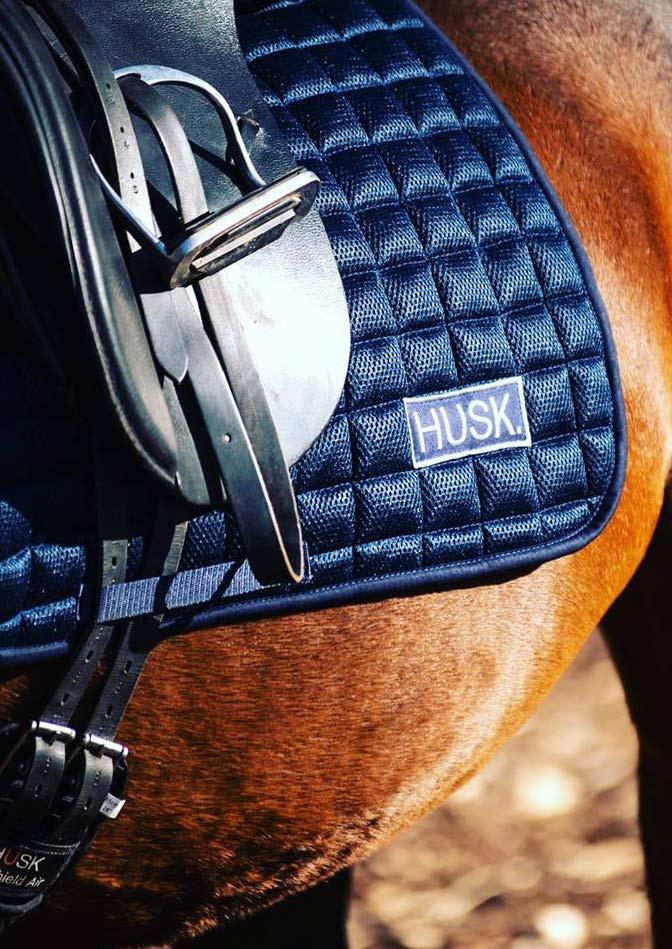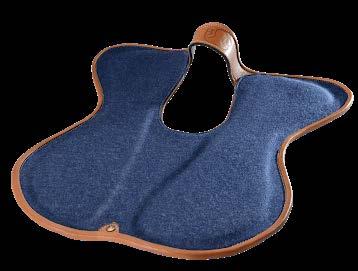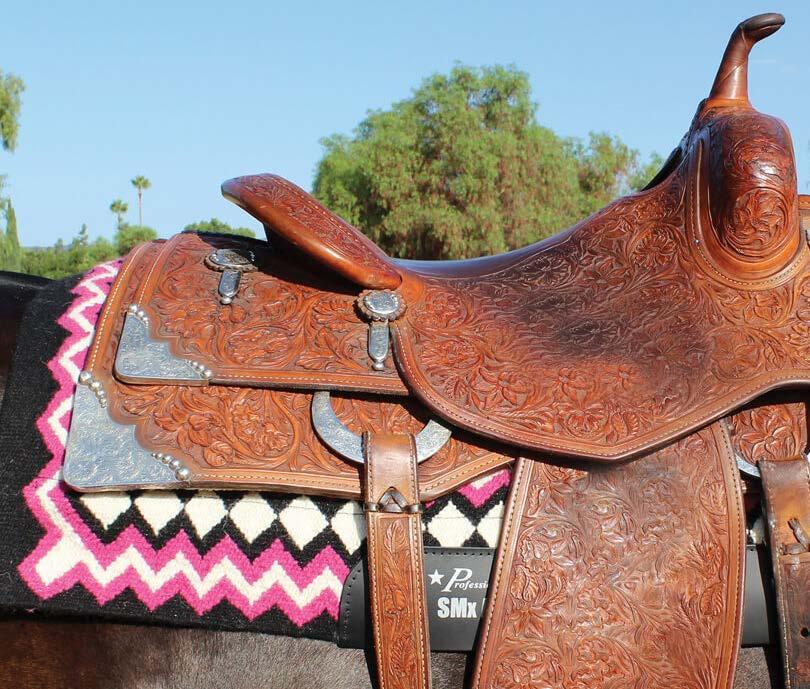
8 minute read
WHAT’S THE DEAL WITH SADDLE CLOTHS?
FEATURE
Saddle Cloths: What’s the Big Deal?
Far from being a mere fashion statement, there’s much more to the humble saddle cloth than meets the eye, as DANNII CUNNANE discovered.
Asaddle cloth is just a pad of material that’s placed under a horse’s saddle, right? Well, yes and no. Originally, saddle cloths were used to protect the leather underside of a saddle from sweat and dirt, both of which have a detrimental effect on leather.
But there’s much more to them than that. For example, in an ideal world, a saddle should fit your horse perfectly, and responsible owners go to great lengths to ensure that that’s the case. However, due to a range of factors a horse may change shape to the point where the saddle no longer fits snuggly. And while a saddle cloth can never take the place of a properly fitted saddle, padded saddle cloths can be used to help in this instance. In fact, there are specially designed cloths that allow for additional padding, known as shims, to be inserted to provide individually tailored workarounds for minor fitting problems. But isn’t it just about fashion?
Saddle cloths are now available in an apparently never-ending array of shapes, colours and materials. From the days of plain cotton pads used to protect the saddle, we have shifted to a fashion-forward combination of colours and styles designed to suit all disciplines.
But saddle cloths aren’t just about keeping up with horse high couture!
Studies in the field of equine ergonomics - the applied science of equipment design that maximises performance by reducing horse fatigue and discomfort - have shown that saddle cloths can play a significant role in the comfort of the horse and how it moves.
Enter the equitation scientists
The equitation scientists (yes, they exist!) who work in this area have investigated different saddle cloth materials, and how pressure and force impact and distribute along the horse’s spine. In order to obtain the necessary data, ultra-thin pressure mats embedded with sensors are placed under the saddle.
These sensors relay information in colour coded real-time video images that allow researchers to calculate the degree of pressure and where it’s located. The sensors are calibrated to differentiate between each gait, and also relay information relating to the friction and pressure points created by different types of materials. JULY 2019 - HORSEVIBES MAGAZINE 23
During these studies, the horse’s heart rate is monitored to determine its comfort and stress levels. High heart rates can indicate discomfort, as can behaviours such as tail swishing, ear pinning, and even bucking. Researchers monitor this behaviour, which adds to the data they collect as they test the comfort of different types and thicknesses of material.
The studies have demonstrated that some saddle cloths actually help to distribute the pressure of the rider and saddle more evenly, while also reducing friction.
And pressure and friction aren’t the only considerations. In an effort to relieve the problem of hot spots along a horse’s spine, researchers have also looked at the way in which heat distribution varies between saddle cloths of different materials and thickness.


So, what’s the verdict?
It would be easy to assume that with all that science going on behind the scenes, the ‘perfect’ saddle cloth would now be ready and waiting for you. Unfortunately, that isn’t the case.
Although the studies have identified trends regarding the positive and negative effects of a variety of materials, research is still in the early stages.
However, some results are in: reindeer fur has topped the list as the best distributor of pressure between the saddle and spine, and sheepskin, with its ability to even out minor irregularities in pressure and to conform to the shape of the saddle, has also received a tick.

What about the design?
Although studies have been conducted on different saddle cloth designs, it’s definitely not a one-shape-fits-all scenario. It really does depend on the needs of each individual horse.
Anatomical saddle cloths that are shaped to pull up high over the withers are useful in preventing shoulder and wither pressure, particularly for horses with high ‘shark fin’ withers. But this type of cloth will not help if the saddle itself is putting pressure on those areas. In fact, it will create even more of a problem.
Another saddle cloth option is a ‘cut out’. As the name suggests, this saddle cloth is cut away so as to relieve potential pressure on the trapezius muscle. Very simply put, this is the muscle that connects the forelimbs to the rest of the horse’s body, so unwanted pressure on the trapezius will obviously impact upon the freedom of the horse’s movement as well as its comfort.
While researchers have discovered that a cut out cloth allows for better distribution of heat and pressure than a full saddle cloth, the problem of pressure on the trapezius muscle should really be remedied with a better fitting saddle. While a cut out cloth might be a short term solution, the horse may well experience greater problems in the long term if the issue with the saddle is not addressed.
Ensure your saddle cloths are clean
While keeping saddle cloths fresh and clean can be a bit of a chore, it’s an important step to keeping your horse comfortable. Built up sweat and dirt can cause irritation and friction, so it’s obviously best to avoid riding with dirty saddle cloths.
You can keep your saddle cloths clean by popping them in the washing machine – but always check labels for the manufacturer’s cleaning instructions before you opt for a good old-fashioned wash and spin!
If immersion in water isn’t an option, you can clean the underside of the cloth with a stiff bristled brush. While you’re doing that, check for any hard spots. Wear and tear can result in the padding becoming compacted or worn down, which will reduce its shock absorbing properties, as well as creating potential pressure points.
And if you have a sheepskin pad, be sure that you use the recommended detergent. Some laundry detergents can destroy natural fibres.


How to know if there’s pressure
While we’re waiting for that hi-tech, problem-solving saddle cloth to hit the shelves, here are some tips that will help you to identify whether your saddle is putting pressure on your horse’s back and causing them discomfort.
Look for the spots: After riding, look for dry spots in the saddle area of your horse’s coat. A dry spot indicates a place where the saddle has applied pressure. These pressure points can be painful and may turn into saddle sores if left without treatment. Another indicator of uneven pressure? Areas of the coat that are more compressed than others.
Check for tenderness: Gently run your fingers along your horse’s spine, especially around the area where the saddle sits. If the horse flinches, moves away, or tries to evade your touch, there may well be an issue with pressure and the fit of the saddle. Be aware of behaviour: Does your horse’s behaviour change while you’re tacking up? Pinned ears, nipping, and raising the legs could indicate that the horse is experiencing discomfort and that further investigation is needed.
So, you’re in the market for a saddle cloth
Saddle cloth manufacturers are incorporating more and more hi-tech features into their designs, and that’s obviously a good thing. However, make sure you do your research before you buy. Be aware of jargon and marketing hype that has little or no evidence to back up its claims! Ask questions and make sure that what you’re purchasing delivers what the marketing promises. Types of saddle cloths
Whatever your riding style, choose a saddle cloth that suits your horse
A Western saddle sporting the thicker western pad to help support the weight of the saddle, and protect the horse’s back.
and is appropriate for your saddle. For example, a saddle cloth which has stitching or seams in areas where the saddle sits can cause unnecessary pressure. Similarly, avoid a cloth that will be pulled down by your saddle and cause discomfort and pressure on your horse’s back and withers.
But to be a little more specific, here are some saddle cloth tips relevant to specific riding styles:
English: To simplify things, we’ve included dressage, show jumping and showing in this category. Inexpensive saddle cloths are probably best avoided for these disciplines. Cheaper cloths usually include man-made materials such as polyester and nylon, which do not have the ability to wick away moisture and can also cause excess heat. They are also less likely to provide the same level of comfort offered by natural fibres such as sheepskin and cotton. Natural fibres tend to reduce pressure points, release heat, and allow moisture to be wicked away - plus they help to keep the horse cooler during summer workouts, and warmer during winter.

Western/Stock: The materials available for western style and stock saddle cloths aren’t as varied as for English saddles. A good option is a Navajo saddle blanket. This is a thickly woven, usually natural fibre cloth that is relatively easy to clean, wicks away moisture and also releases heat. The downside is that they can bunch up or slip if the saddle doesn’t fit properly.
Woven pads are also an option. However, these have been known to cause both friction and pressure spots. If you’re considering purchasing a pad, ensure the thickness is appropriate for both your horse and saddle, and choose a material that isn’t synthetic. Pads made of compressed wool or a breathable foam are the best option, while synthetic
fleece, neoprene and polyester can cause excess heat and trap sweat.
Of course, when all is said and done, a properly fitted saddle that distributes pressure evenly across the horse’s back, coupled with a good saddle cloth that ‘fills in the gaps’ is the optimal solution.
No saddle cloth can truly correct the problems that arise from a poorly fitting saddle, so consider arranging for an accredited saddle fitter to check that your horse and your saddle are a good match. Your horse’s improved performance will be reward enough!













